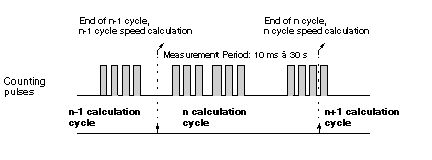In addition to the up / down counting function, the TSX CTY 2C module can execute the speed measurement function.
This function can be used with the counting sensors (which generate the pulses) or with the absolute encoders (which generate a word describing a position).
Strictly speaking, the position acquisition is not a pulse counting or down counting process, but the same result is obtained using successive writings in the counting register.
The principle of the speed calculation is that of the frequency meter: the speed is calculated and updated on a period set by the user, in number of points per second. The default measurement period value is 1 second.
The following illustration shows the principle of measurement:
The sampling period must be chosen according to the desired precision and the speed (frequency) lower limit of the signal to be measured, using the following formula:
where the precision is expressed as a decimal value (for example: 0.1% = 0,001) and the speed (pulse frequency) in thousands of points/second (kHz). The sampling period is calculated in milliseconds.
Example: for a 40,000 to 250,000 points/second pulse frequency and a desired precision of 0.1%, the minimum sampling period is 25 ms.
NOTE: the minimum sampling period is 10 ms.
Principle of speed monitoring
Speed monitoring makes it possible to set to 0 the reflex outputs after a configurable speed threshold overrun and to command directly a safety device (for example).

